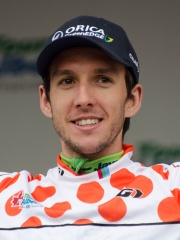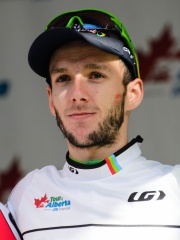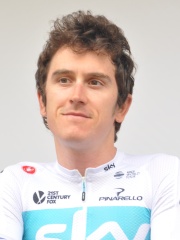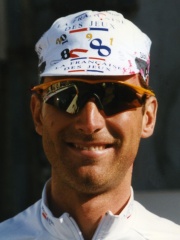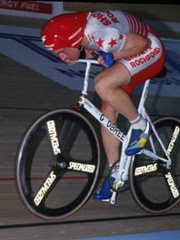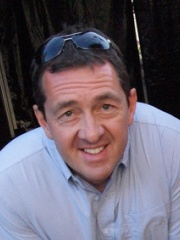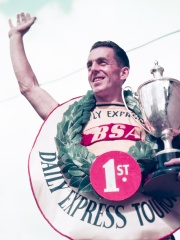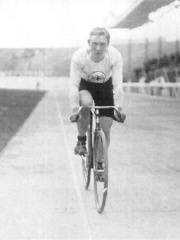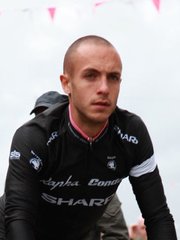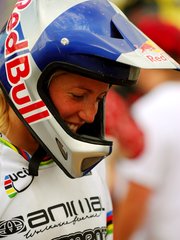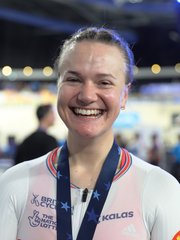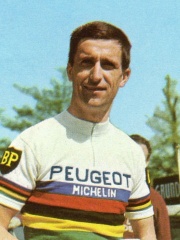

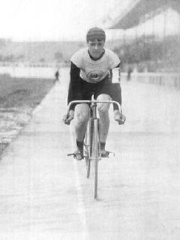
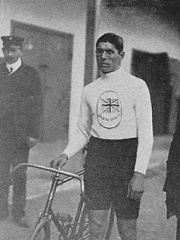

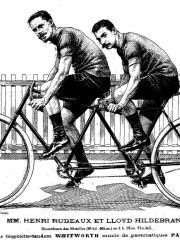
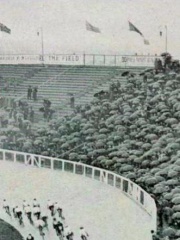
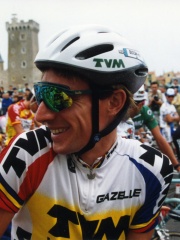
The Most Famous
CYCLISTS from United Kingdom
This page contains a list of the greatest British Cyclists. The pantheon dataset contains 1,613 Cyclists, 94 of which were born in United Kingdom. This makes United Kingdom the birth place of the 7th most number of Cyclists behind Germany, and Netherlands.
Top 10
The following people are considered by Pantheon to be the top 10 most legendary British Cyclists of all time. This list of famous British Cyclists is sorted by HPI (Historical Popularity Index), a metric that aggregates information on a biography's online popularity. Visit the rankings page to view the entire list of British Cyclists.

1. Tom Simpson (1937 - 1967)
With an HPI of 66.06, Tom Simpson is the most famous British Cyclist. His biography has been translated into 30 different languages on wikipedia.
Thomas Simpson (30 November 1937 – 13 July 1967) was one of Britain's most successful professional cyclists. He was born in Haswell, County Durham, and later moved to Harworth, Nottinghamshire. Simpson began road cycling as a teenager before taking up track cycling, specialising in pursuit races. He won a bronze medal for track cycling at the 1956 Summer Olympics and a silver at the 1958 British Empire and Commonwealth Games. In 1959, at age 21, Simpson was signed by the French professional road-racing team Saint-Raphaël–R. Geminiani–Dunlop. He advanced to their first team (Rapha–Gitane–Dunlop) the following year, and won the 1961 Tour of Flanders. Simpson then joined Gitane–Leroux–Dunlop–R. Geminiani; in the 1962 Tour de France he became the first British rider to wear the yellow jersey, finishing sixth overall. In 1963 Simpson moved to Peugeot–BP–Englebert, winning Bordeaux–Paris that year and the 1964 Milan–San Remo. In 1965 he became Britain's first professional world road race champion and won the Giro di Lombardia; this made him the BBC Sports Personality of the Year, the first cyclist to win the award. Injuries hampered much of Simpson's 1966 season. He won two stages of the 1967 Vuelta a España before he won the general classification of Paris–Nice that year. In the thirteenth stage of the 1967 Tour de France, Simpson collapsed and died during the ascent of Mont Ventoux. He was 29 years old. The post-mortem examination found that he had mixed amphetamines and alcohol; this diuretic combination proved fatal when combined with the heat, the hard climb of the Ventoux and a stomach complaint. A memorial near where he died has become a place of pilgrimage for many cyclists. Simpson was known to have taken performance-enhancing drugs during his career, when no doping controls existed. He is held in high esteem by many fans for his character and will to win.

2. Frederick Keeping (1867 - 1950)
With an HPI of 64.72, Frederick Keeping is the 2nd most famous British Cyclist. His biography has been translated into 26 different languages.
Frederick Keeping (11 August 1867 – 21 February 1950) was a British racing cyclist. He competed at the 1896 Summer Olympics in Athens. Keeping competed in the 333 metres and 12 hours races. In the 12 hours race, Keeping was one of only two cyclists to finish, covering 314.664 kilometres. He was only one lap behind the winner, Adolf Schmal, who covered 314.997 kilometres. Keeping tied with two others for fifth place in the 333m, with 27.0 seconds.

3. Benjamin Jones (1882 - 1963)
With an HPI of 59.02, Benjamin Jones is the 3rd most famous British Cyclist. His biography has been translated into 20 different languages.
Benjamin Jones (2 January 1882 – 20 August 1963) was a British track cycling racer who competed in the 1908 Summer Olympics. In 1907, he won the one and five mile events at the British Empire cycling championships at Newcastle. Soon after, his professional cyclist license was revoked after an altercation with another cyclist. His attendance at the 1908 Olympics was thus in question until he was finally reinstated just before the event. In 1908, he won the gold medal in the 5000 metres competition as well as in the team pursuit as a member of the British team. He also won a silver medal in the 20 kilometres event. He competed in the 660 yards competition but was eliminated in the semi-finals. In the sprint event, he participated in the final and came second, but the pre-arranged time limit was exceeded, resulting in the race being declared void and no medals being awarded.

4. Leonard Meredith (1882 - 1930)
With an HPI of 57.03, Leonard Meredith is the 4th most famous British Cyclist. His biography has been translated into 21 different languages.
Leonard "Leon" Lewis Meredith (2 February 1882 – 27 January 1930) was a British track and road racing cyclist who competed in the 1908 Summer Olympics, in the 1912 Summer Olympics, and in the 1920 Summer Olympics. He won seven world championships, set up one of Britain's largest cycle-parts companies, and ran a roller skating rink and ballroom.
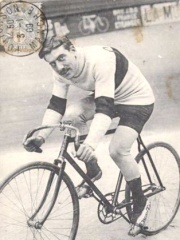
5. Georges Passerieu (1885 - 1928)
With an HPI of 55.67, Georges Passerieu is the 5th most famous British Cyclist. His biography has been translated into 15 different languages.
George Leon Passerieu (London, 18 November 1885–Épinay-sur-Orge, 5 May 1928) was a British-born French professional road bicycle racer, who won seven stages in the Tour de France, and reached the podium twice. He also was the winner of Paris–Roubaix and Paris–Tours.

6. Phil Anderson (b. 1958)
With an HPI of 55.38, Phil Anderson is the 6th most famous British Cyclist. His biography has been translated into 22 different languages.
Philip Grant Anderson (born 20 March 1958) is an Australian former professional racing cyclist who was the first non-European to wear the yellow jersey of the Tour de France.

7. Lloyd Hildebrand (1870 - 1924)
With an HPI of 55.17, Lloyd Hildebrand is the 7th most famous British Cyclist. His biography has been translated into 16 different languages.
Lloyd Augustin Biden Hildebrand (25 December 1870, in Tottenham, United Kingdom – 1 April 1924, in Levallois-Perret, France) was a British-born racing cyclist who competed in the late 19th century and early 20th century. Hildebrand was still a British citizen in 1900, although he lived in France for much of his life and married a Frenchwoman. He participated in cycling at the 1900 Summer Olympics in Paris, winning the silver medal in the men's 25 kilometre race. as well as the bronze medal 1900 Track Cycling World Championships. Historically, his Olympic success was regarded as a British medal, but in 2024 his success was reassigned to France by the International Olympic Committee.

8. Charles Henry Bartlett (1885 - 1968)
With an HPI of 55.09, Charles Henry Bartlett is the 8th most famous British Cyclist. His biography has been translated into 15 different languages.
Charles Henry Bartlett (6 February 1885, in Bermondsey, London – 30 November 1968, in Enfield) was a British track cyclist. He competed in the 1908 Summer Olympics where he won the gold medal in the 100 kilometres competition, completing the course in a time of 2 hours 41 minutes and 48.6 seconds.

9. Philippa York (b. 1958)
With an HPI of 55.09, Philippa York is the 9th most famous British Cyclist. Her biography has been translated into 19 different languages.
Philippa York (born Robert Millar on 13 September 1958) is a Scottish journalist and former professional road racing cyclist. York, who competed when known as Robert Millar, is one of Britain's most successful cyclists. York won the "King of the Mountains" competition in the 1984 Tour de France and finished fourth overall. This success was the first time a British rider won a major classification in the men's tour, and was unsurpassed as the highest Tour finish for a Briton for over 20 years until Bradley Wiggins was retrospectively placed third in the 2009 Tour de France. York started the Tour de France eleven times, finishing eight times. York finished second in the 1987 Giro d'Italia and also won the King of the Mountains classification. This was the highest finish by a Briton in the Giro d'Italia until Chris Froome won the 2018 race. As well as the Giro second-place finish, York finished second in two other Grand Tours: the 1985 and 1986 Vuelta a España. The second place at the 1985 Vuelta came after losing the leader's jersey on the penultimate stage, in what is widely thought to have been collusion by the Spanish-speaking teams. Further victories came at the 1985 Volta a Catalunya, the 1989 Tour of Britain and the 1990 Critérium du Dauphiné Libéré. After retiring in 1995, York moved into journalism, as well as spending a year as a coach for British Cycling. She reduced her public commitments in 2000 following hostile stories regarding rumours of her gender transition, and after an appearance as Millar at the 2002 Commonwealth Games left public life altogether. In the 2010s, having transitioned to living as York, she returned to journalism, publishing under the name of Robert Millar, until a decision to reveal her transition publicly by appearing on television in 2017 in a commentary role.
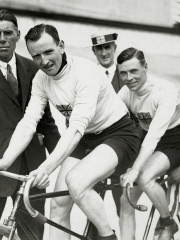
10. Harry Ryan (1893 - 1961)
With an HPI of 54.88, Harry Ryan is the 10th most famous British Cyclist. His biography has been translated into 17 different languages.
Harry Edgar Ryan (21 November 1893 – 14 April 1961) was a British track cycling racer. Ryan came second in the world amateur sprint championship in 1913. He competed at the 1920 Summer Olympics and won the tandem competition with Thomas Lance, as well as a bronze medal in the sprint. Ryan lived at 312 Euston Road, St Pancras, London in 1901. His father was a cutler, toolmaker and shopkeeper of Buck & Ryan. After retiring from competitions, Ryan converted Buck & Ryan into a successful concern. He also became a prominent cycling administrator, supervising most of the major competitions in Europe.
People
Pantheon has 105 people classified as British cyclists born between 1867 and 2004. Of these 105, 89 (84.76%) of them are still alive today. The most famous living British cyclists include Phil Anderson, Philippa York, and Simon Yates. The most famous deceased British cyclists include Tom Simpson, Frederick Keeping, and Benjamin Jones. As of April 2024, 15 new British cyclists have been added to Pantheon including Gary Anderson, Josh Tarling, and Daniel Bigham.
Living British Cyclists
Go to all RankingsPhil Anderson
1958 - Present
HPI: 55.38
Philippa York
1958 - Present
HPI: 55.09
Simon Yates
1992 - Present
HPI: 53.45
Adam Yates
1992 - Present
HPI: 51.92
Geraint Thomas
1986 - Present
HPI: 50.81
Donald Burgess
1933 - Present
HPI: 50.59
Max Sciandri
1967 - Present
HPI: 49.19
Graeme Obree
1965 - Present
HPI: 48.98
Ronald Keeble
1941 - Present
HPI: 48.39
Laura Kenny
1992 - Present
HPI: 47.63
Dan Martin
1986 - Present
HPI: 47.34
Chris Boardman
1968 - Present
HPI: 47.30
Deceased British Cyclists
Go to all RankingsTom Simpson
1937 - 1967
HPI: 66.06
Frederick Keeping
1867 - 1950
HPI: 64.72
Benjamin Jones
1882 - 1963
HPI: 59.02
Leonard Meredith
1882 - 1930
HPI: 57.03
Georges Passerieu
1885 - 1928
HPI: 55.67
Lloyd Hildebrand
1870 - 1924
HPI: 55.17
Charles Henry Bartlett
1885 - 1968
HPI: 55.09
Harry Ryan
1893 - 1961
HPI: 54.88
Alan Newton
1931 - 2023
HPI: 54.44
Gordon Thomas
1921 - 2013
HPI: 53.62
Clarence Kingsbury
1882 - 1949
HPI: 52.88
George Newberry
1917 - 1978
HPI: 52.82
Newly Added British Cyclists (2025)
Go to all RankingsGary Anderson
1967 - Present
HPI: 43.76
Josh Tarling
2004 - Present
HPI: 36.05
Daniel Bigham
1991 - Present
HPI: 36.03
James Knox
1995 - Present
HPI: 34.26
Jonathan Tiernan-Locke
1984 - Present
HPI: 32.07
Rachel Atherton
1987 - Present
HPI: 31.54
James Shaw
1996 - Present
HPI: 30.46
Matthew Richardson
1999 - Present
HPI: 30.11
Charlie Tanfield
1996 - Present
HPI: 29.17
Matthew Holmes
1993 - Present
HPI: 29.07
Jessica Roberts
1999 - Present
HPI: 28.56
Sophie Capewell
1998 - Present
HPI: 28.53
Overlapping Lives
Which Cyclists were alive at the same time? This visualization shows the lifespans of the 15 most globally memorable Cyclists since 1700.

